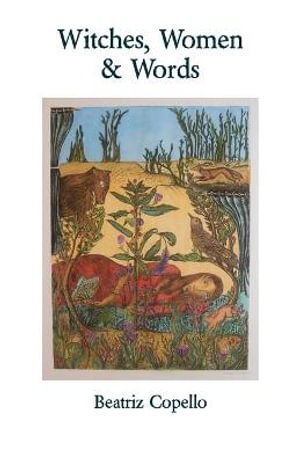 Review by Janet Reinhardt
Review by Janet Reinhardt
Witches, Women & Words
By Beatriz Copello
Ginninderra Press
ISBN: 9781761092879, Paperback, 68 pages, 13th April 2022
Witches, Women and Words is the latest collection by well-known Sydney poet Beatriz Copello. The book is arranged into three sections “Witches”, “Humans” and “The Social Order or Disorder”. Throughout this collection the poet argues strongly for the rights of women while foregrounding their innate strengths. She reflects on the way the social order, including the church has conspired to oppress the feminine but also finds solace in the natural world, which is seen as women’s true habitat where ‘Mother Earth embraces each and every one’.
The principal themes of the first section of the collection are anger at the historical and continuing abuse of women by the patriarchy and at the complicity of the Church in this abuse. In “Witches Brew” the speaker in the poem throws into a ‘cauldron’ the instruments of oppression. These include her ‘… first communion veil’, her ‘… mother’s wedding ring’, and history books that tell only men’s stories while ignoring those of women. By the poem’s conclusion the speaker has concocted a ‘brew’ that gives birth to a ‘new woman’. The following poem, “Genesis” suggests that this new woman is a creator not a destroyer. Using words chosen with total economy, this poem outlines the creative act using the trope of magic to weave an ‘artistic spell’ in which ‘words/are strung/ one after the other/ like beads/in a necklace’. This spare poem has no room for redundant elaboration as it directly describes the genesis of its own creation.
Perhaps the strongest poem in this section is “The Angelus Call While the Witches Dance”. Haunted images of ‘Gullible devouts’ en route to the evening prayer are contrasted with the freedom of witches who dance in a forest in ‘Crowns of rosemary and lavender flowers.’ As a ‘sorrowful procession’ of ‘Weathered faces’ with ‘furtive looks’ and ‘hands that tremble/ finger their rosary beads’, an accusatory god who ‘never forgets’, ‘watches’, ‘judges’ and ‘points his finger … ’. The penitents appear enslaved by an unforgiving ‘almighty’ while, paradoxically, the pagan witches, who sing and pray in the open air are both joyful and free.
The section of the book entitled “Humans” deals with a range of issues that can affect a human life. It contains two fine poems dealing with the writing life. “Mortuus Est” ably describes the crippling situation of writer’s block. The writer finds the ‘tongue in his mind is mute’ and ‘prays to the god inside … who has jailed his stanzas/and anchored his lines’ to set them free. He asks rhetorically whether ‘the critic inside (has) killed the poet?’ On the adjacent page the poem “My Friend the Poet” describes the bleak end of a fellow ‘pauper poet’ who dies alone in a room where ‘poems written on sheets of paper/make a blanket on his limp body.’ The direct description of the room where the poet is found serves to emphasise the melancholy of the scene where ‘A light bulb hangs/ from the ceiling/on a black cord/ covered in flies.’
“Humans” also contains a poem about the recent bushfires. “Refugee” follows a woman who escaped a bushfire only to end up in her car with nowhere to go. As ‘fires sprouted like mushrooms’ and ‘violent flames … devoured’ and ‘climbed the old gum trees like agile athletes’, the subject in the poem asks desperately ‘Where now? Where now?’ The poem “Wisteria” describes a scene from the poet’s early life when a child played under a wisteria vine praying ‘to an omnipotent god/who never heard’. The child prays beneath the ‘Purple shawl’ of flowers in Spring in an attempt to save her parents’ marriage. As the inevitable seasons pass, the child continues to hope. Although ‘the flowers died’ when ‘summer came’, ‘the wisteria dressed itself with its best green’. But by Autumn when ‘one by one/the brilliant leaves/turned to gold/and like miniature kites/descended onto the patio.’ The child sees the ‘house sold/the suitcases packed’ and has to accept the failure of her prayers. All that remains is ‘the memory of the wisteria in flower’ and one may assume the beginning of a loss of faith.
The collections third section, “Social Order or Disorder” is perhaps not as strong as the previous two although there are still some poems of note. Perhaps the best of these is “Up North” which describes a road trip through an alien landscape where ‘Red ochre, vibrant soil … like notes penetrate/not only the eyes but the soul.’ There are ‘pink flowers’ to ‘break the monotony’ alongside ‘The sad lament of crows’ and roadkill, ‘a dead kangaroo victim’. The poet records the ‘Solitude of waterholes’ under a ‘cloudless blue’. This poem roves like a handheld camera over an impassive and ‘bejewelled land’. Outback Australia comes alive in this poem.
About the reviewer: Janet Reinhardt is a Sydney based poet and artist whose work has appeared in journals throughout Australia as well as in the UK and USA. Her manuscript A Thought Adrift was recently long listed for the Flying Islands manuscript prize.